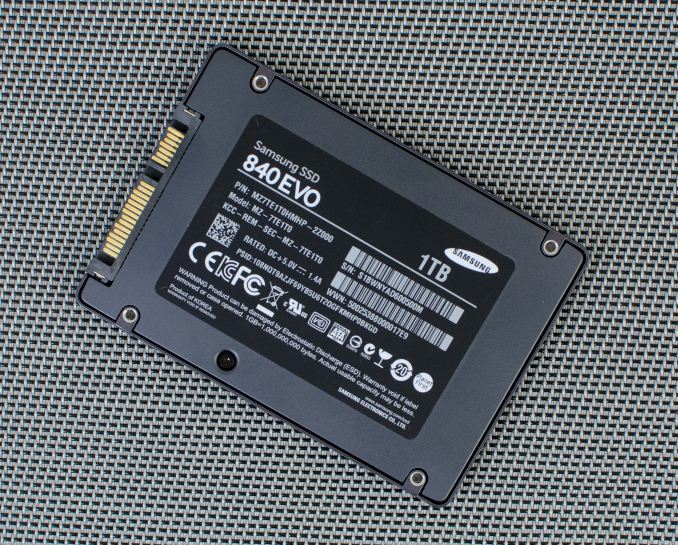Firmware Update to Fix the Samsung SSD 840 EVO Read Performance Bug Coming on October 15th
by Kristian Vättö on September 26, 2014 5:10 PM EST
A week ago Samsung acknowledged the existence of the read performance bug in the SSD 840 EVO and I just received a note that the fixed firmware is in validation process and is expected to be released to the public on October 15th. Unfortunately I don't have any further details about the bug or the fix at this point, or whether the update is coming to the 'vanilla' SSD 840 and OEM models, but I hope to get more details as the public release gets closer, so stay tuned.










84 Comments
View All Comments
FunBunny2 - Saturday, September 27, 2014 - link
Even the Wikipedia acknowledges that there are two, in general, wear leveling approaches: static and dynamic. They differ in the way you'd expect based on the names: the static leveling does re-write all blocks over time, while dynamic only re-writes as needed by new writes. At one time, probably 3 or so years ago, wearing leveling was understood to be static. When the dynamic version came into use? That would be an AnandTech question.hojnikb - Saturday, September 27, 2014 - link
Dynamic was used (and probobly still is) by pretty much every cheap nand controller in the past, because its much simpler and works decent enough with sequential workload (eg flashdrives or memory cards).Solid State Brain - Monday, September 29, 2014 - link
Old data however also needs more ECC time for being reliably read, meaning lower performance. As user reactions show, this is clearly not acceptable in the consumer world.To me it seems just weird that Samsung would deliberately defer static wear leveling to the point that old data has impaired read performance and possibly that dynamic wear leveling would operate on a reduced amount of NAND blocks, especially given that the possible benefits in write amplification by doing so don't seem that great compared to SSDs / SSD controllers that do not seem to employ such techniques.
I believe it's likely that this was a genuine bug that Samsung is going to fix rather than an indended behavior which the company would be attempting to cover up to save face.
BTW, I would also check for TRIM behavior after the updated firmware gets released. It could have been a side effect of this bug.
hojnikb - Saturday, September 27, 2014 - link
> In any case, I can't understand why the Samsung Pro MLC's are so much more expensive compared to everyone else's MLC drives?Because they are faster. Samsung rather uses best quality MLC for their top drives and best quality TLC for their value line.
Others just use cheaper MLC (be that of lower quality/bin, bigger die or smaller litograhpy).
xwingman - Saturday, September 27, 2014 - link
Thanks for your post! Will this affect this model of drive: Samsung 840 evo MZ-7TE120BW single unit version?? I'm pretty new to ssd's and this will be my primary ssd for the os and a few programs. I don't want to have to do a firmware fix and have it all messed up. Thx.Proffo - Sunday, September 28, 2014 - link
I don't think TLC endurance is a problem for most users. Most of us will have dumped our EVOs well before they are "worn out". Even if this fix halves the life of the EVO, it won't be much of an issue.iLovefloss - Sunday, September 28, 2014 - link
True for 240GB capacities or larger, but the 120GB TLC drives only barely last long enough for a modern upgrade cycle. Anything that cuts the life expectancy down for the 120GB drives will be kind of a problem.sweeper765 - Saturday, September 27, 2014 - link
It's good that a date has been set for the firmware fix but Samsung needs to answer a lot more:1. Explain the details of the problem and how the fix works.
2. Does the new firmware affect the SSD life? How much?
3. Is the speed fully restored or is there going to be a certain read speed value (fixed by Samsung in the firmware) that triggers the data relocation ? If it is so then it will still be degradation just not so severe.
All in all, Samsung should have done a better job with this drive.
To quote from their site:
"End-to-end integration of in-house components (NAND/Controller/DRAM/Firmware)"
But this proved to be more of a weakness than an advantage.
NAND - 19nm TLC with low endurance and potentially poor data retention
Controller - overheats ; they could have at least put some thermal pads on it
Firmware - buggy
Solid State Brain - Saturday, September 27, 2014 - link
If the issue is that old static data is not getting shuffled around, a new firmware correcting this issue will actually improve the SSD's life as it will ensure that all memory cells will wear up uniformly, not just the ones holding dynamic, new data.hojnikb - Saturday, September 27, 2014 - link
Not necesserly. If you shuffle all the data around, this can actually increase write amplification, while giving static data a smaller priority when doing wear levelling (so doing more dynamic wearlevelling than static).Some cheap controllers (usually found in cheapst flash drives/memory cards) dont do any static wearlevelling at all.